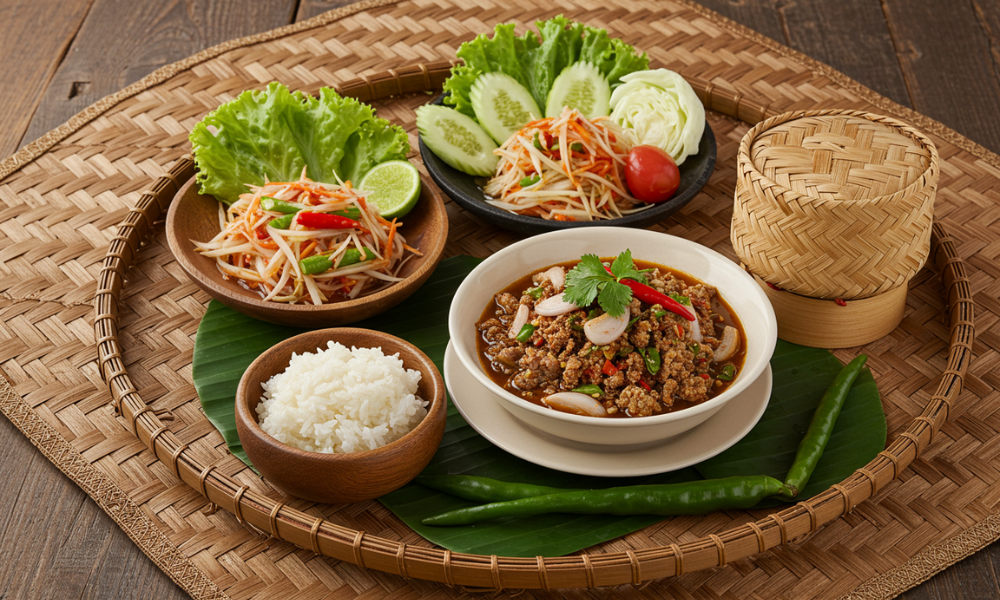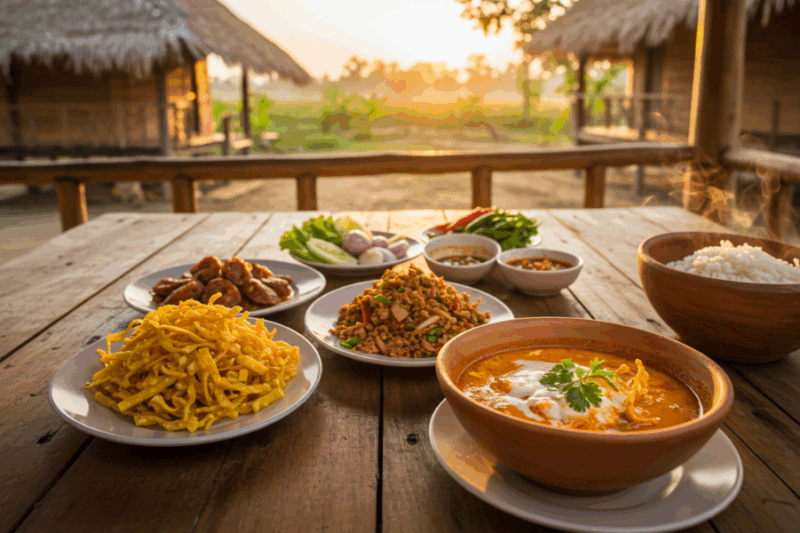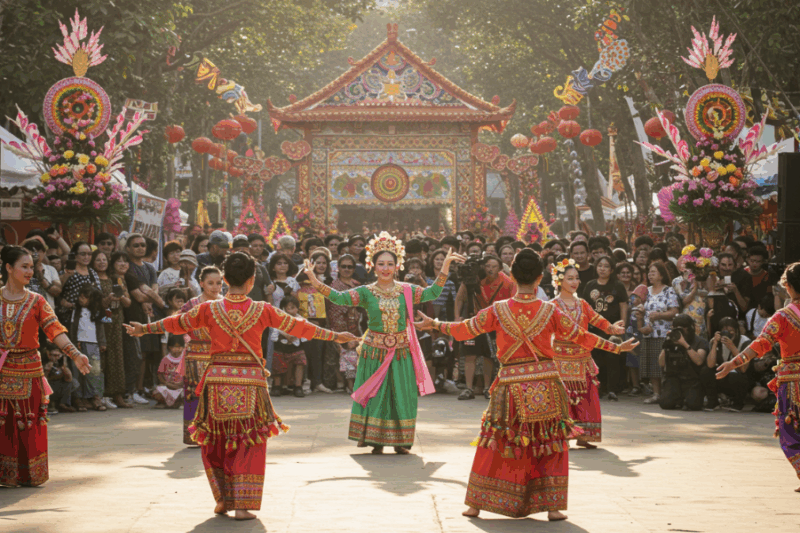Laos, a landlocked gem in Southeast Asia, offers a cuisine that’s bold, fresh, and deeply tied to its rural roots and Buddhist traditions. For minimalist travelers, exploring Laotian food is a perfect way to immerse yourself in culture with just a carry-on and an appetite. From Vientiane’s bustling markets to Luang Prabang’s riverside stalls, these dishes are affordable, authentic, and unforgettable. Here are the top five traditional Laotian foods you must try, with tips to enjoy them while keeping your travel light and budget-friendly.

1. Laap (Larb)
Laap, often considered Laos’ national dish, is a spicy minced meat salad made with pork, chicken, beef, or fish, mixed with lime juice, fish sauce, chili, mint, and toasted sticky rice powder. Served with sticky rice and fresh herbs, it’s a vibrant mix of tangy, spicy, and savory flavors. A plate costs 10,000–20,000 LAK ($0.50–1) at local markets or 30,000–50,000 LAK ($1.50–2.50) at restaurants. For minimalist travelers, it’s a single-dish meal, easy to eat with your hands (roll sticky rice into balls), requiring no extra gear. Why Try: Bold, fresh flavors; a quintessential Laotian experience.
Where to Eat: Night Market in Luang Prabang or Ban Anou Market in Vientiane. Try Tamarind Restaurant (Luang Prabang) for a refined version.
Tip: Request “pet nit noi” (less spicy) if sensitive to heat.
2. Sticky Rice (Khao Niaw)
Sticky rice is a Laotian staple, served in small bamboo baskets (tip khao) and eaten with your hands. It’s steamed to a chewy texture, perfect for pairing with laap, jeow (spicy dips), or grilled meats. A basket costs 5,000–10,000 LAK ($0.25–0.50) at street stalls. For travelers, it’s portable and filling, ideal for a minimalist diet—carry a reusable container ($10) for leftovers. Locals eat it at every meal, reflecting Laos’ agrarian culture. Why Try: Simple, authentic, and versatile; a cultural must.
Where to Eat: Morning markets like Phosy Market (Vientiane) or roadside stalls in Luang Namtha.
Tip: Pinch small amounts and dip into sauces for the full experience.
3. Tam Mak Hoong (Green Papaya Salad)
Tam mak hoong is a fiery green papaya salad, shredded and pounded with chili, lime, fish sauce, garlic, and sometimes crab or fermented fish paste (padaek). It’s crunchy, tangy, and spicy, costing 10,000–20,000 LAK ($0.50–1) at street vendors or 25,000–40,000 LAK ($1.25–2) at eateries. For minimalist travelers, it’s a light, nutrient-packed dish, perfect for hot days (30°C/86°F), requiring only a spoon. Why Try: Zesty and refreshing; a Southeast Asian classic with a Laotian twist.
Where to Eat: Vientiane’s Dong Palane Market or Luang Prabang’s street stalls near Phousi Hill.
Tip: Say “mai pet” (not spicy) to adjust heat levels.
4. Khao Piak Sen (Rice Noodle Soup)
Khao piak sen is a comforting chicken or pork noodle soup with thick, chewy rice noodles in a fragrant broth, garnished with herbs, chili, and lime. It’s a breakfast favorite, costing 15,000–25,000 LAK ($0.75–1.25) at markets or small shops. For travelers, it’s a one-bowl meal, easy to find and filling, ideal for early starts to temple visits or treks. No utensils needed beyond a spoon and chopsticks. Why Try: Warm, hearty, and soul-soothing; perfect for any time of day.
Where to Eat: Morning stalls near Talat Sao (Vientiane) or Ban Xiengkeo Market (Luang Prabang).
Tip: Add chili paste for a spicy kick, but taste first—it’s potent.
5. Ping Kai (Grilled Chicken)
Ping kai is marinated, grilled chicken, often spatchcocked and cooked over charcoal, served with a side of sticky rice and jeow (chili dip). The smoky, juicy meat costs 20,000–40,000 LAK ($1–2) at roadside stalls or markets. For minimalist travelers, it’s a mess-free, protein-rich dish, perfect for eating on the go or pairing with a Lao beer ($1). It’s a street food staple, reflecting Laos’ love for simple, bold flavors. Why Try: Smoky, savory, and universally loved; a crowd-pleaser.
Where to Eat: Night markets in Vang Vieng or street vendors along Vientiane’s Mekong Riverside.
Tip: Pair with a tam mak hoong for a balanced meal.
Tips for Enjoying Laotian Food as a Minimalist Traveler
- Eat Local: Hit markets like Luang Prabang’s Night Market or Vientiane’s Talat Khua Din for dishes at $0.50–2, saving $5–10/day compared to restaurants.
- Pack Light: Carry a reusable water bottle ($15) and a cloth napkin ($5) to reduce waste; most dishes use spoons or hands, so no extra utensils needed.
- Budget Wisely: A day’s meals (breakfast, lunch, dinner) costs $3–7, keeping total daily expenses at $15–25 (hostel $5–10, transport $2–5).
- Try Street Food: Choose busy stalls with high turnover for fresh food; visit during peak hours (6–8 AM for breakfast, 5–7 PM for dinner).
- Respect Hygiene: Pick vendors with clean setups (e.g., covered food, fresh ingredients). Carry hand sanitizer ($3) for pre-meal use.
- Learn Phrases: Use “sabaidee” (hello) or “khop chai” (thank you) to connect with vendors. Say “mai sai padaek” if avoiding fermented fish paste.
- Cultural Sensitivity: Be open to strong flavors like padaek or bitter herbs; start with milder dishes like ping kai if new to Laotian cuisine.
Why Laotian Food Suits Minimalist Travel
Laotian cuisine is ideal for minimalist travelers: it’s cheap, accessible, and served in markets or street stalls, requiring no fancy dining or heavy gear. Dishes like laap and khao piak sen deliver bold flavors in simple formats, letting you focus on cultural immersion without financial strain. By eating locally, you support small vendors and keep costs low (~$5–7/day for meals), leaving room for Mekong cruises ($10) or temple visits ($1–2). Compared to pricier Thai or Vietnamese dining ($10–20/day), Laos is a budget traveler’s delight.



